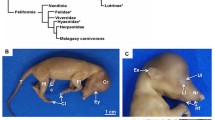Abstract
The villous bidiscoid placenta in utero of a proboscis monkey with a fetus of 9.0 cm crown rump length was examined. The immature male fetus weighed 56 g and had a 5.4 cm head circumference. Of particular interest was the stomach, consisting of three parts, large fundus, a narrow tubular portion, and a small pyloric region. The fetal adrenal glands were remarkable in that they were larger than the kidneys. Thus, the adrenal/kidney weight ratio approximated 1.18.
The marginally inserted umbilical cord measured 15 cm. Owing to the superficial implantation in the proboscis monkey, penetration of syncytiotrophoblast and a fibrin layer were not observed in the basal plate of the placenta; cytotrophoblastic cell columns attached to the basal plate, consisting of decidua basalis without invasion of trophoblastic giant cells. Intraarterial trophoblastic migration was found in the uterus.
Similar content being viewed by others
References
Beck, A. J. &F. Beck, 1967. The origin of intra-arterial cells in the pregnant uterus of the macaque (Macaca mulatta).Anat. Rec., 158: 111–114.
Hamilton, W. J. &J. D. Boyd, 1960. Development of the human placenta in the first three months of gestation.J. Anat., 94: 297–328.
Hill, J. P., 1932. The developmental history of the primates.Philos. Trans., (B) 221: 45–178.
Houston, M. L., 1971. Placenta. In:Embryology of the Baboon,A. G. Hendrickx (ed.), Univ. Chicago Press, Chicago, pp. 153–172.
Luckett, W. P., 1974. Comparative development and evolution of the placenta in primates.Contrib. Primatol., 3: 142–234.
Moser, H. G. &K. Benirschke, 1962. Fetal zone of the adrenal gland in the nine-banded armadillo,Dasypus novemcinctus. Anat. Rec., 143: 47–59.
Napier, J. R. &P. H. Napier, 1967.A Handbook of Living Primates. Academic Press, New York.
Selenka, E., 1900. Entwicklung des Gibbon (Hylobates und Siamanga).Fortsetzung. Stud. Entw. Gesch. Tiere, 8: 173–208.
Spatz, W. B., 1968. Nabelschnur-Längen bei Insektivoren und Primaten. J.Säugetierk., 33: 226–239.
Torpin, R., 1969. Placentation in the rhesus monkey (Macaca mulatta).Obstet. Gynec., 34: 410–413.
Van Wagenen, G. &H. R. Catchpole, 1965. Growth of the fetus and placenta of the monkey (Macaca mulatta)Am. J. Phys. Anthrop., 23: 23–34.
Wislocki, G. B., 1929. On the placentation of the primates, with a consideration of the phylogeny of the placenta.Contrib. Embryol., 20: 51–80.
Author information
Authors and Affiliations
About this article
Cite this article
Soma, H., Benirschke, K. Observations on the fetus and placenta of a proboscis monkey (Nasalis Iarvatus). Primates 18, 277–284 (1977). https://doi.org/10.1007/BF02383106
Received:
Accepted:
Issue Date:
DOI: https://doi.org/10.1007/BF02383106




